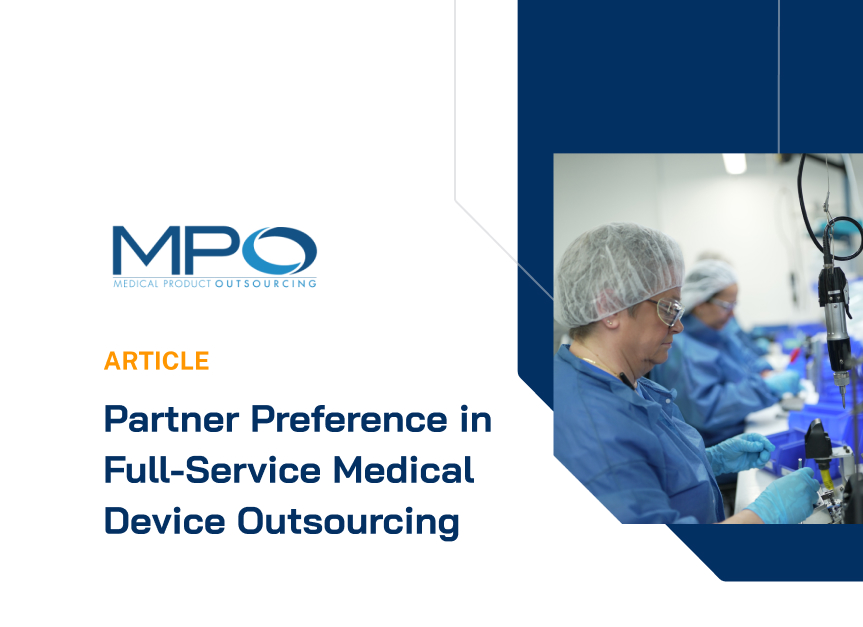
Excerpted from Medical Product Outsourcing. Read the full article.
Recent events have created a reevaluation of medical device manufacturing suppliers and a quest for true partners to achieve mutual success. To gain inputs on this topic, Sean Fenske, MPO Editor-in-Chief, spoke with a group of medtech leaders including Aptyx CEO Gregg Tobin.
Sean Fenske: From your perspective, what is the outsourcing situation in medtech? Growing, shrinking, or about the same?
Gregg Tobin: Overall, the outsourcing market is growing, and I expect that will continue for the foreseeable future for several reasons. Outsourcing affords medtech OEMs the opportunity to grow faster and use their investment dollars more efficiently. When OEMs rely on a contract manufacturer like Aptyx to handle manufacturing, they can invest in other areas like regulatory, commercial strategy, and R&D.
Contract manufacturers can also provide the more complex manufacturing technologies required to support the growth of OEMs. As devices become more advanced and more miniaturized, OEMs are not necessarily funding these advanced technologies internally. So we see a greater reliance on contract manufacturers who are investing heavily in those manufacturing technologies.
Finally, outsourcing partners can be instrumental in helping to ensure continuity of supply with nearshoring and offshoring.
Fenske: Did lessons learned/reactions from the pandemic have an effect on this direction/change? How/Why?
Tobin: Yes. Since the pandemic, OEMs have been analyzing their supply chains more closely, rethinking what is insourced and what is outsourced, and identifying critical paths. There’s been a shift, with less reliance on Asia outsourcing and more nearshoring to ensure supply chain continuity.
Before the pandemic, many OEMs were working on tightening up their supplier base. Then their supplier base expanded during the pandemic, and now they’re working to rein it back in. It doesn’t necessarily mean less outsourcing; it just means more focused outsourcing. It’s all about having the right partners.
Fenske: Is M&A activity within the industry having an effect on the OEM/CMO relationship? If so, what is the impact?
Tobin: For us, M&A is a strategic tool that allows us to bring deeply specialized capabilities into one network to provide a complete source for all the technology and capabilities our OEM customers need to produce a product. I view it as a very strong positive to support our customers globally.
On the OEM side, they’re making acquisitions to add capabilities to better support their providers and bring clinical solutions to better address outcomes. They often need to strengthen the supply chain of these acquisitions, and they may not have the solutions or capacity readily available in-house. Companies like ours can step in immediately to add capacity quickly to support their growth and ensure business continuity.
Fenske: What recommendations do you have for OEMs currently seeking new CMO suppliers? How can they best evaluate a prospective partner and what traits should be considered most important?
Tobin: I’d say the OEM needs to make sure they’ve identified a partner that aligns with their values and strategic priorities. For us at Aptyx, quality is number one and engineering is the heartbeat of the company, so those are the two most critical elements.
The baseline is identifying partners whose capabilities are a good fit with the OEM’s product needs to ensure they can focus on finding solutions, not just checking boxes or taking orders. The ability to be nimble and flexible in identifying solutions is another really important attribute for us.
Finding a supplier partner who has a global vision and strategy to support worldwide growth is also important. That’s where financial strength and stability come in. At Aptyx, we’re investing in our infrastructure, facilities, people, and processes like global quality systems as well as strategic M&A to acquire those assets and capabilities that make us a stronger manufacturing partner for our customers. If I were an OEM, I’d be looking at a CMO to understand their philosophy on investing. Do they have the financial strength and experience to invest and grow? That’s critically important.
Fenske: What steps must an OEM take in order to evolve from dealing with a CMO purely as a supplier to establishing a true collaborative partnership with that CMO?
Tobin: Involving your partner early on is key—engaging at the earliest stage to collaborate as partners throughout the project. It’s also important to be clear on what you’re trying to achieve so together, you can find the best solution. And of course, honesty, transparency, and good communication are vital.
Fenske: Conversely, what does a CMO need to do to illustrate to an OEM it is capable of being a collaborative partner in a medical device project?
Tobin: It’s all about listening to understand, not just trying to sell services. The mindset is, “What is the right solution we can provide, and how do we win together?”
Fenske: Have you continued with any virtual practices such as virtual tours with your customers and/or suppliers since the pandemic or are you fully back to in-person activities?
Tobin: During the pandemic, we all learned how effective virtual collaboration can be, and we’re building on the strength of virtual tools. Of course, in-person communication is still important, so it’s a balance.
We’re standing up virtual engineering tools to drive productivity and deliver expertise when and where it’s needed—tools that allow an engineer to lend expertise at a location halfway around the world. For example, we’re adding virtual reality for process validation and optimization.
Fenske: Have you been impacted or participated in the nearshoring/reshoring trend? Have OEM customers inquired about you moving to/opening a facility closer to them?
Tobin: We absolutely embrace nearshoring and reshoring and are actively working with our customers to address these opportunities. We’re a partner with a diverse global network, and it’s part of our business model to invest and grow to support our customers. We’re extremely flexible, and because we’re well-capitalized, we’re able to make investments to partner with customers to support nearshoring.
For example, we’ve invested proactively in a team that specializes in the transfer of tools from overseas facilities to domestic production, and we have in-house tooling expertise to expedite and solve complex transfers.
Fenske: Social awareness programs have faced backlash recently and many companies are refocusing their efforts. Has your company altered its direction with regard to DEI (diversity, equity, and inclusion) or ESG (environmental, social, and corporate governance) campaigns?
Tobin: We’re a new company and have integrated more than a dozen business units in the past year into the new Aptyx brand. We’re just starting our ESG efforts. These areas are important for building a thriving culture that people want to be part of, and to be a responsible member of our local communities.
These activities are core to our values. We’re building out the leadership to drive them within our organization as we continue to grow.
Fenske: When faced with an OEM customer who presents consistent requests for a percentage cost reduction year over year, does it cause a rift in the relationship or a reevaluation of whether the customer’s business is worth it? (or, have you experienced this at all?)
Tobin: I view this as a positive and welcome these opportunities to work in collaboration with our customers. We understand our customers are looking for cost productivity—that’s business. We embrace this and do the best we can through innovation and re-engineering to drive productivity. As part of our culture supporting Lean, Six Sigma, and kaizen, we’re always looking to boost efficiency so we can be more cost-effective for our customers. As a growing company, we’re able to create specialty solutions for our customers’ needs that optimize the cost of manufacturing.
Fenske: The industry is experiencing a shortage of skilled labor for many positions. How is your company addressing this and what are you doing to attract/retain/develop talent?
Tobin: As a new brand that comprises more than a dozen companies, we’re focusing on building a culture around our vision, mission, and values and establishing Aptyx as a great place to work. A key part of our mission is to positively impact people’s lives, including the lives of our team members. We live our value of “Growth Mindset” through a culture of learning that enables us to develop a robust workforce. Some examples include our successful apprenticeship programs, partnering with local trade schools, and Aptyx University, which offers a range of classes from Lean/Six Sigma to communications and capabilities training.
Fenske: What trend(s) in medtech will you be following in the near- and/or long-term you expect to become more important or could have a significant impact on the industry? Explain.
Tobin: We’re following trends that are impacting manufacturing as well as clinical and therapeutic markets. On the manufacturing side, we’ve embarked on Industry 4.0 and are strengthening our road map to leverage technology like virtual reality for our integrated companies and suite of capabilities.
Some of the medtech trends we’re following include “smart devices,” growth in robotic-assisted applications, connected care, and the move from hospital to home or point-of-care that’s driving diagnostics and so many other markets.
We’re proactively planning to ensure we have the capacity to accommodate our customers’ needs in these high-growth areas. For example, the gears and actuators we manufacture are integral to robotic-assisted surgery systems, wearables, home care infusion pumps, and more.

